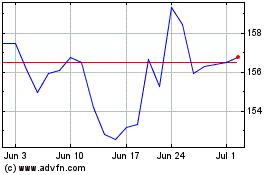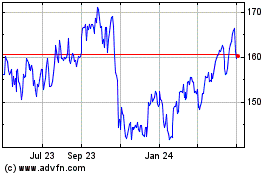Chevron Corporation (NYSE: CVX) today provided an overview of
the company’s business performance and plans at its 2024 Annual
Meeting of Stockholders.
“Chevron continues to deliver strong operational performance,
maintain cost and capital discipline and consistently return cash
to shareholders,” said Michael Wirth, Chevron’s chairman and CEO.
“We’ve strengthened our portfolio to grow both traditional and new
energy supplies by advancing major capital projects and completing
strategic acquisitions.”
Chevron delivered the highest production in company history with
annual production of 3.1 million barrels of oil-equivalent per day
in 2023, underscoring the company’s track record of strong
leadership and worldwide demand for affordable and reliable energy.
This year’s first quarter performance marked the company’s ninth
consecutive quarter with adjusted earnings over $5 billion and
adjusted ROCE above 12 percent.
In the Gulf of Mexico, Chevron reached first oil at the Mad Dog
2 project and completed installation of the floating production
unit for the Anchor field, an important milestone toward achieving
first production this year. In downstream, Chevron continues to
evolve its refining system to produce lower carbon intensity fuels
and products, by converting the diesel hydroheater at its El
Segundo refinery to process either 100 percent renewable or
traditional feedstocks.
The completed acquisition of PDC Energy, Inc. boosts Chevron’s
U.S. presence in the DJ and Permian Basins by a total of 300,000
net acres, while the completed acquisition of a majority stake in
ACES Delta, LLC accelerates the development of a green hydrogen
production and storage hub in Utah.
“Our financial priorities remain unchanged – grow the dividend,
invest capital efficiently, maintain a strong balance sheet and
return excess cash to stockholders,” Wirth said. “It’s also
important to recognize that we’ve maintained our financial strength
with a single-digit net debt ratio and continue to achieve our
objective of safely delivering higher returns, lower carbon and
superior shareholder value in any business environment.”
The preliminary results from the meeting can be accessed online
at www.chevron.com. Final voting results on all agenda items will
be posted in the same location after they have been reported on a
Form 8-K, which will be filed with the U.S. Securities and Exchange
Commission. Specific information about the proposals before Chevron
stockholders this year may be found in the “Investors” section of
the company’s website under “Stockholder Services – Annual Meeting
Materials.”
Chevron is one of the world’s leading integrated energy
companies. We believe affordable, reliable and ever-cleaner energy
is essential to enabling human progress. Chevron produces crude oil
and natural gas; manufactures transportation fuels, lubricants,
petrochemicals and additives; and develops technologies that
enhance our business and the industry. We aim to grow our oil and
gas business, lower the carbon intensity of our operations and grow
lower carbon businesses in renewable fuels, carbon capture and
offsets, hydrogen and other emerging technologies. More information
about Chevron is available at www.chevron.com.
NOTICE
As used in this news release, the term “Chevron” and such terms
as “the company,” “the corporation,” “our,” “we,” “us” and “its”
may refer to Chevron Corporation, one or more of its consolidated
subsidiaries, or to all of them taken as a whole. All of these
terms are used for convenience only and are not intended as a
precise description of any of the separate companies, each of which
manages its own affairs.
Please visit Chevron’s website and Investor Relations page at
www.chevron.com and www.chevron.com/investors, LinkedIn:
www.linkedin.com/company/chevron, Twitter: @Chevron, Facebook:
www.facebook.com/chevron, and Instagram: www.instagram.com/chevron,
where Chevron often discloses important information about the
company, its business, and its results of operations.
CAUTIONARY STATEMENTS RELEVANT TO
FORWARD-LOOKING INFORMATION FOR THE PURPOSE OF “SAFE HARBOR”
PROVISIONS OF THE PRIVATE SECURITIES LITIGATION REFORM ACT OF
1995
This news release contains forward-looking statements relating
to Chevron’s operations and lower carbon strategy that are based on
management’s current expectations, estimates, and projections about
the petroleum, chemicals and other energy-related industries. Words
or phrases such as “anticipates,” “expects,” “intends,” “plans,”
“targets,” “advances,” “commits,” “drives,” “aims,” “forecasts,”
“projects,” “believes,” “approaches,” “seeks,” “schedules,”
“estimates,” “positions,” “pursues,” “progress,” “may,” “can,”
“could,” “should,” “will,” “budgets,” “outlook,” “trends,”
“guidance,” “focus,” “on track,” “goals,” “objectives,”
“strategies,” “opportunities,” “poised,” “potential,” “ambitions,”
“aspires” and similar expressions, and variations or negatives of
these words, are intended to identify such forward-looking
statements, but not all forward-looking statements include such
words. These statements are not guarantees of future performance
and are subject to numerous risks, uncertainties and other factors,
many of which are beyond the company’s control and are difficult to
predict. Therefore, actual outcomes and results may differ
materially from what is expressed or forecasted in such
forward-looking statements. The reader should not place undue
reliance on these forward-looking statements, which speak only as
of the date of this news release. Unless legally required, Chevron
undertakes no obligation to update publicly any forward-looking
statements, whether as a result of new information, future events
or otherwise. Among the important factors that could cause actual
results to differ materially from those in the forward-looking
statements are: changing crude oil and natural gas prices and
demand for the company’s products, and production curtailments due
to market conditions; crude oil production quotas or other actions
that might be imposed by the Organization of Petroleum Exporting
Countries and other producing countries; technological
advancements; changes to government policies in the countries in
which the company operates; public health crises, such as pandemics
and epidemics, and any related government policies and actions;
disruptions in the company’s global supply chain, including supply
chain constraints and escalation of the cost of goods and services;
changing economic, regulatory and political environments in the
various countries in which the company operates; general domestic
and international economic, market and political conditions,
including the military conflict between Russia and Ukraine, the
conflict in Israel and the global response to these hostilities;
changing refining, marketing and chemicals margins; actions of
competitors or regulators; timing of exploration expenses; timing
of crude oil liftings; the competitiveness of alternate-energy
sources or product substitutes; development of large carbon capture
and offset markets; the results of operations and financial
condition of the company’s suppliers, vendors, partners and equity
affiliates; the inability or failure of the company’s joint-venture
partners to fund their share of operations and development
activities; the potential failure to achieve expected net
production from existing and future crude oil and natural gas
development projects; potential delays in the development,
construction or start-up of planned projects; the potential
disruption or interruption of the company’s operations due to war,
accidents, political events, civil unrest, severe weather, cyber
threats, terrorist acts, or other natural or human causes beyond
the company’s control; the potential liability for remedial actions
or assessments under existing or future environmental regulations
and litigation; significant operational, investment or product
changes undertaken or required by existing or future environmental
statutes and regulations, including international agreements and
national or regional legislation and regulatory measures related to
greenhouse gas emissions and climate change; the potential
liability resulting from pending or future litigation; the ability
to successfully integrate the operations of the company and PDC
Energy, Inc. and achieve the anticipated benefits from the
transaction, including the expected incremental annual free cash
flow; the risk that regulatory approvals with respect to the Hess
Corporation (Hess) transaction are not obtained or are obtained
subject to conditions that are not anticipated by the company and
Hess; potential delays in consummating the Hess transaction,
including as a result of regulatory proceedings or the ongoing
arbitration proceedings regarding preemptive rights in the Stabroek
Block joint operating agreement; risks that such ongoing
arbitration is not satisfactorily resolved and the potential
transaction fails to be consummated; uncertainties as to whether
the potential transaction, if consummated, will achieve its
anticipated economic benefits, including as a result of regulatory
proceedings and risks associated with third party contracts
containing material consent, anti-assignment, transfer or other
provisions that may be related to the potential transaction that
are not waived or otherwise satisfactorily resolved; the company’s
ability to integrate Hess’ operations in a successful manner and in
the expected time period; the possibility that any of the
anticipated benefits and projected synergies of the potential
transaction will not be realized or will not be realized within the
expected time period; the company’s future acquisitions or
dispositions of assets or shares or the delay or failure of such
transactions to close based on required closing conditions; the
potential for gains and losses from asset dispositions or
impairments; government mandated sales, divestitures,
recapitalizations, taxes and tax audits, tariffs, sanctions,
changes in fiscal terms or restrictions on scope of company
operations; foreign currency movements compared with the U.S.
dollar; higher inflation and related impacts; material reductions
in corporate liquidity and access to debt markets; changes to the
company’s capital allocation strategies; the effects of changed
accounting rules under generally accepted accounting principles
promulgated by rule-setting bodies; the company’s ability to
identify and mitigate the risks and hazards inherent in operating
in the global energy industry; and the factors set forth under the
heading “Risk Factors” on pages 20 through 26 of the company’s 2023
Annual Report on Form 10-K and in subsequent filings with the U.S.
Securities and Exchange Commission. Other unpredictable or unknown
factors not discussed in this news release could also have material
adverse effects on forward-looking statements.
reconciliation of non-GAAP measures
Adjusted earnings and adjusted ROCE
$ millions
1Q22
2Q22
3Q22
4Q22
1Q23
2Q23
3Q23
4Q23
1Q24
Reported earnings
6,259
11,622
11,231
6,353
6,574
6,010
6,526
2,259
5,501
Noncontrolling interest
18
93
7
25
31
(2)
29
(16)
50
Interest expense (A/T)
126
120
117
113
106
111
104
111
109
ROCE earnings
6,403
11,835
11,355
6,491
6,711
6,119
6,659
2,354
5,660
Annualized ROCE earnings
25,612
47,340
45,420
25,964
26,844
24,476
26,636
9,416
22,640
Average capital employed1
173,871
178,615
182,033
183,425
183,611
182,226
183,810
184,786
183,128
ROCE (%)
14.7%
26.5%
25.0%
14.2%
14.6%
13.4%
14.5%
5.1%
12.4%
Reported earnings
6,259
11,622
11,231
6,353
6,574
6,010
6,526
2,259
5,501
Special items
Asset dispositions
-
200
-
-
-
-
-
-
-
Pension settlement & curtailment
costs
(66)
(11)
(177)
(17)
-
-
(40)
-
-
Impairments and other2
-
(600)
-
(1,075)
(130)
225
560
(3,715)
-
Total special items
(66)
(411)
(177)
(1,092)
(130)
225
520
(3,715)
-
Foreign exchange
(218)
668
624
(405)
(40)
10
285
(479)
85
Adjusted earnings
6,543
11,365
10,784
7,850
6,744
5,775
5,721
6,453
5,416
Noncontrolling interest
18
93
7
25
31
(2)
29
(16)
50
Interest expense (A/T)
126
120
117
113
106
111
104
111
109
Adjusted ROCE earnings
6,687
11,578
10,908
7,988
6,881
5,884
5,854
6,548
5,575
Annualized adjusted ROCE earnings
26,748
46,312
43,632
31,952
27,524
23,536
23,416
26,192
22,300
Average capital employed1
173,871
178,615
182,033
183,425
183,611
182,226
183,810
184,786
183,128
Adjusted ROCE (%)
15.4%
25.9%
24.0%
17.4%
15.0%
12.9%
12.7%
14.2%
12.2%
1 Capital employed is the sum of Chevron
Corporation stockholders’ equity, total debt and noncontrolling
interests. Average capital employed is computed by averaging the
sum of capital employed at the beginning and the end of the
period.
2 Includes impairment charges, write-offs,
decommissioning obligations from previously sold assets, severance
costs, unusual tax items, and other special items.
Note: Numbers may not sum due to
rounding.
reconciliation of non-GAAP measures Net
debt ratio
$ millions
1Q24
Short term debt
282
Long term debt*
21,553
Total debt
21,835
Less: Cash and cash equivalents
6,278
Less: Marketable securities
-
Total adjusted debt
15,557
Total Chevron Corporation Stockholders’
Equity
160,625
Total adjusted debt plus total Chevron
Stockholders’ Equity
176,182
Net debt ratio
8.8%
* Includes capital lease obligations /
finance lease liabilities.
Note: Numbers may not sum due to
rounding.
View source
version on businesswire.com: https://www.businesswire.com/news/home/20240529325900/en/
Randy Stuart -- +1 713-283-8609
Chevron (NYSE:CVX)
Historical Stock Chart
From Jun 2024 to Jul 2024

Chevron (NYSE:CVX)
Historical Stock Chart
From Jul 2023 to Jul 2024
